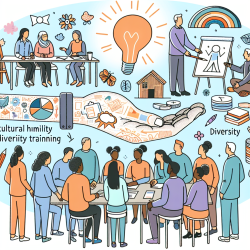Introduction
In the ever-evolving landscape of public services, the integration of codesign approaches with vulnerable populations is gaining momentum. The research article "Codesigning health and other public services with vulnerable and disadvantaged populations: Insights from an international collaboration" provides valuable insights into this process. As practitioners, understanding and implementing these findings can significantly enhance service delivery, especially in fields like online therapy for schools, such as those offered by TinyEYE.
Understanding Codesign
Codesign involves the active participation of service users in the design, management, delivery, and evaluation of public services. This approach acknowledges the expertise of service users, especially those from vulnerable populations, in improving service outcomes. The research highlights several challenges and principles that practitioners can adopt to enhance their skills and service delivery.
Key Challenges in Codesign
- Engagement: Initial recruitment and sustained engagement of participants from vulnerable groups can be challenging due to their unique circumstances.
- Power Differentials: Managing power imbalances between service users and providers is crucial for meaningful participation.
- Health Concerns: Health vulnerabilities can affect participation in codesign processes.
- Economic and Social Circumstances: These factors can hinder consistent participation, especially for youth and economically disadvantaged groups.
- Funding Challenges: Codesign with vulnerable populations is resource-intensive and requires dedicated funding and support.
Principles for Effective Codesign
To address these challenges, the research suggests several principles and tactics:
- Trust and Flexibility: Building on existing trust and being flexible in participation options can enhance engagement.
- Empowerment and Power Sharing: Empowering service users and sharing power across perspectives can lead to more effective codesign outcomes.
- Understanding and Respect: Understanding the history and context of each group and respecting cultural differences are essential for successful codesign.
- Demonstrating Impact: Evaluating and demonstrating the impact of codesign processes can garner support from funders and stakeholders.
Implementing Codesign in Practice
For practitioners, integrating these principles into daily practice can lead to improved service outcomes. For instance, in online therapy services like those provided by TinyEYE, practitioners can use codesign to tailor services to the specific needs of schoolchildren, ensuring that their voices are heard and valued.
Encouraging Further Research
While the current research provides a solid foundation, further exploration is encouraged. Practitioners should consider conducting additional research to adapt codesign principles to their specific contexts and populations. This continuous learning approach will help refine and improve service delivery over time.
To read the original research paper, please follow this link: Codesigning health and other public services with vulnerable and disadvantaged populations: Insights from an international collaboration.










